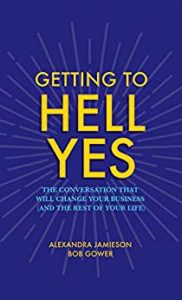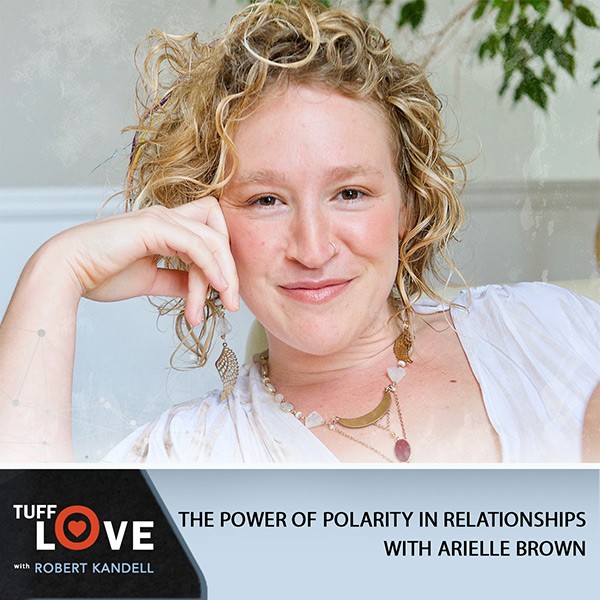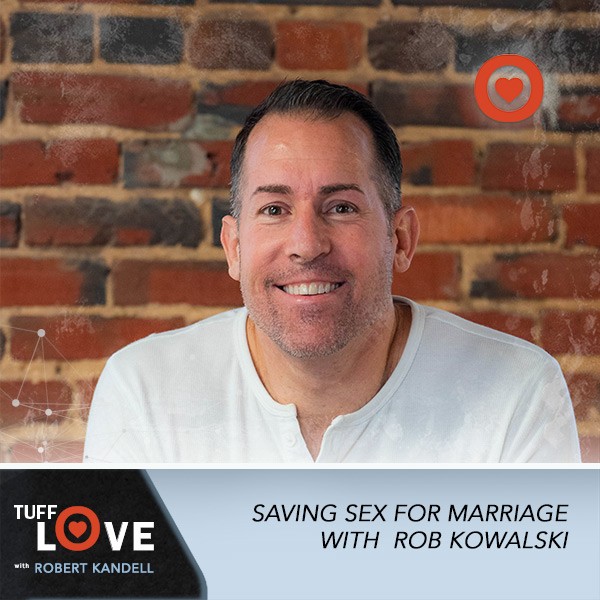
165: Getting To Hell Yes with Alexandra Jamieson and Bob Gower
Oct 23, 2018
Getting to Hell Yes will teach you a simple, guided methodology that allows groups to increase empathy and trust. It can be used in sales, when launching a team, or at any point during the project where some refocus is needed. Alexandra Jamieson and Bob Gower believe passionately that the world needs more people who know how to build aligned and empathic relationships — in businesses, communities, and families — through powerful, clear conversations. They have created this tool as a catalyst for positive change in your organization and your life.
165: Getting To Hell Yes with Alexandra Jamieson and Bob Gower

Getting to Hell Yes: The conversation that will change your business (and the rest of your life)
I’m so excited to be here with two old friends, Bob Gower and Alexandra Jamieson. Bob, I’ve known from the old days, for a long time, when we were young men. Now we’re older gentlemen with fine gray hair and the powerful, wonderful, magical, brilliant Alexandra. We’re here talking about them and their adventure of Getting to Hell Yes. Starting off with the book they’re producing, I love to welcome you to the show. How’s it going?
Thanks for having us.
It’s my absolute pleasure. My first question is what was the motivation for the book? Everyone thinks about writing books, you have this great concept that works. You’ve been using it for seven years. What had you gone from concept into production?
People kept asking us, “What was that conversation again?” We kept getting texts and phone calls.
We were tired of explaining it to people. Originally the idea was to write a Google Doc. We’re not very sharp people sometimes and we like to think we’re in business, but there was very strong market signal that this was a valuable thing and that we could produce something around it, make a book, make a product around it. We didn’t take it seriously, I guess.
We were sharing it in some couples workshops that we were teaching together. After every single workshop, people would contact us again saying, “What was that four-part thing again?” I taught it to a friend of mine who ended up writing the introduction for the book and it was so transformative for her marriage and how she parents all in her five kids. Bob was in a taxi, re-explaining it to someone and by the time he was done explaining it to the person on the phone, the taxi driver was like, “That was a great conversation. I was listening to it, thanks.” We kept getting feedback that this was helping people. I’m like, “Let’s do this.”
I was using it in my work too. I taught it to a bunch of consultants that I work with and it had become a core. We have maybe 30 to 50 different workshop tools that we pull from on a regular basis and this had become one of the regular canon items. I had a lot of stuff around it. I had done a lot of thinking about it in that context and then we were using it our relationship. It was an all these different contexts so then we had to write about it. That was where it got interesting because I don’t know if you feel this way, I know you’ve written a book, that you often don’t know what you think about something until you write about it. That’s like putting up a flag in the sand or whatever. It took me a while, we rewrote the book three times as we went through it and it became significantly shorter each time.
This is my fifth, our first co-written book, there was a second. It became clear that this was something we wanted to put out on our own, self-publish it so that we could get it out there and do it in the format and structure that we wanted to do. We want to have more creative control.
We’d been exploring it for a couple of years. We took it into agents and we talked to so many different people about how to approach it. What market to have it speak to? The writing was a journey.
Let’s get down to the basic concept. The technique is ICBD: intention, concern, boundary and dream. Can you take the audience through the basic path through it?
Before we get to the four steps, there’s a thing before which is what’s the context that you’re going to use it then. We always think of this as something that you can use whenever you have two or more people, which is not quite accurate because you can use it by yourself as well. I definitely use it by myself to gain clarity, but it’s before you’re going to do something that is likely to raise some emotion. It’s likely that it feels important to one or more person involved. We use it when we were talking about our relationship and the future of our relationship, which is an emotionally laden topic and out of the conversation. We both have been married before, so marriage wasn’t high on our list. Being together was, but the marriage part wasn’t. Through the conversation we’re like, “We should probably get married.” Getting married seems like the logical next step. It leads us and then we used it to plan the wedding. We’ve also used it before we go visit cantankerous family members. I’ve used it when launching change programs in very large companies with leadership teams.
I teach it to clients all the time about how to have high stakes or highly emotional conversations.
There are probably a lot of hidden landmines, whenever you’re doing something with somebody. It’s helpful to know where those landmines are because one, you can determine that, “There are so many land mines here, this is dangerous and we shouldn’t even venture into this thing.” Sometimes you may discover that it’s a bad idea to do what you’re getting ready to do and that’s always good before you’ve invested time, money, and energy into that. You may discover more likely that even though we have these landmines, we can navigate around them, we can develop some strategies together and some empathy and sympathy for each other and be like, “I’m about to get to a place that’s going to be difficult for you, so let’s put a failsafe in place,” essentially.
That’s the context and then the idea is that the conversation is there are four areas where we find landmines common. The first is the intention, and intention is why you’re going to do something. We might use this before going on vacation and two people can go on vacation for wildly different reasons, even very similar looking vacations. One person can want adventure and excitement or stimulation and new experiences and the other person is exhausted from their work and wants to restore and relax. You can go to Southern Spain and get both of those things. It’s knowing the why.
I use this whenever I started work project and my why usually looks like I want to learn some stuff, have fun, deepen my relationship with my partners, and make money. Throughout this whole conversation, we want people to increase their comfort and to create a safe space to talk about things that are normally socially taboo, that are normally a little bit scary. I often lead with, “I’m here to make money.” It’s such a taboo if I worked in a purpose-driven environment but honestly, I wouldn’t do over half the chops that I do if I wasn’t being paid well to do them because of the realities of the world. Do you have any other intentions there?
You often don't know what you think about something until you write about it. Click To TweetNo, that’s good. Each person shares their intentions. A little rule of the game is that you’re not arguing points. You’re clarifying questions at any point, but not sneaky manipulative questions. Getting clear is fine, but you’re there to get the lay of the land. Once every person has shared their intentions, you move onto concerns. Concerns are a great way to give that lizard brain, that part of every single human being that’s concerned with survival at least be heard. We go into it with an understanding that expresses the tiny concerns, the big worries, the crazy ones that you know aren’t going to happen. We’ve had a couple of times where we’ve gone into ICBD together and even talking about writing this book, we use the process that we wrote about in the book to write the book. One of our shared concerns was that this will go horrible and we’ll hate each other and our relationship will suffer. Air out all of your concerns and that goes into a psychological tool called self-talk, where if you put them all out and then you realize, “I’ve shared my biggest worries and I’m not dead.” I made it. I’m still alive. Then the Amygdala can calm down and you can move forward.
You quoted this from our friend who’s a neuroscientist. He talks about that there’s a real power in speaking and hearing, that it has a neurological impact on you. When you talk about the thing that you’re concerned about and your brain hears it, it changes the way your cognition works and allows you to relax a little bit. That’s the self-talk that we’re talking about here.
Everybody shares their concerns.
We encourage people to be crazy because we are, we’re nuts.
The kookie ones and the tiny ones. Get them all out there so that you can realize which happens for most conversations that 95% of your concerns are repetitive thoughts that are making you crazy inside. Once you get them out, they can quiet down.
The next one is boundaries. That shows up a little different depending on the context you’re in. I use this in a business context a lot. I always encouraged people to think of boundaries as the rules around self-care that allow them to show up the best that they can be in that work environment. It’s common these days to talk about like we want engagement out of our people. We want people to do their best work and that work is often both creative and emotional labor in a lot of work contexts. We forget that if we want people to come in and do their best in that way, that they have to be well resourced. They have to be rested, they have to be healthy, they have to be focused.
I was doing an exercise with an energy company that was talking about the switching error. What happens is people are out working on the lines and they forget to switch. They forget the power down the lines that they’re working on. Even though it’s a simple step by step process to do it, they forget to double check themselves. When that happens, they can lose a limb or lose their life. We started talking about how to manage attention, and I’m working with another neuroscientist on this. How to manage attention in this environment. What we forget is that if you’re overworking people, if this is somebody who’s twelve hours on the job or if they’ve had a bad day, their girlfriend broke up or boyfriend broke up with them that morning or some emotional upset is happening, their resources are going to be worse off.
This is an opportunity for people to examine and often people don’t. In my experience, they don’t do it much. The things that I’ll say is when Alex, my stepson, and our son is with us, which is half the time, then I do my best to be home for dinner by 5:30 or 6:00 because that’s an important thing to me. I might be willing to work late other days. I’m also not generally willing to travel more than three nights away from home for the same reason, for family reasons. Just like laying out the boundaries that allow me to show up the best I can be at work. Do you have anything to add?
To take it to a personal realm, whenever we go on vacation, we went to visit my family. We run through this almost every single time together and it gets quick. I do it a couple of times and it becomes a very easy habit to ingrain in a relationship. Bob reminded me of a boundary that we both have when we go visit the other’s family which is, “I need an hour on my own. I need to take the car and go to a coffee shop and settle ground and then I’ll come back.” It’s so great that we trust each other to take care of our own needs. I know Bob’s needs, he’s got himself under control.
That’s one of our core boundaries around our relationship is that we don’t argue if we’ve had any alcohol, even one glass of wine or something, if we are hungry or if we’re exceptionally tired. We’re like, “Let’s take care of those things first before we try to problem-solve an emotional upset,” and it’s amazing.
Boundaries are self-care things that you need to show up to be your best. Everybody shares their boundaries and another little rule that we have, which is you might discover a new boundary and after this conversation and you’re going forward in your life, you realize, “I have a new boundary” and you can real quick connect about it or, “Remember that old boundary? I need to change it. That boundary is not applicable anymore.”

Getting To Hell Yes: Boundaries are self-care things that you need to show in order to be your best.
It can be, “I love your boundary. I’m taking that too. That’s a great boundary. I want that boundary.”
After everybody shares their boundaries. One other thing, you might not get everything you want. This is not ordering off a menu. This is not a catalog where you get to pick out color and size and everything.
It’s not even a negotiation. This occurred to me and it’s weird that I figured this out. If you know anything about systems theory or complex systems, which is the world that I live in when it comes to organizations, in order to change patterns, you have to interrupt the pattern that you’re having. Often, interrupting the pattern is enough and the new pattern conform. I don’t know if this makes any sense, but I think of it as a way to interrupt the old pattern, but it’s not about what the pattern is going to be. We’re not making any decisions, we’re sharing information and developing empathy for each other.
To me, that in and of itself is tough because we’re so used to listening with an agenda. We’re so used to listening to either, “I’m going to have to take these notes so then we can problem solve all of this stuff later.” My experience with this is that this conversation, without having to do a lot of work, it allows for the new pattern to develop. It’s like, “We’ll do that work at the end,” not like, “Let’s not deal with each concern. Let’s go through the whole conversation because the part we’re getting ready to get to is the fun part, is my favorite part.” It puts you in a great frame of mind, a great neurological space in order to do any problem solving that you might need to do down the road.
That brings us to dreams or desires. We call it different things, but it always ends up on desires, always ends on a high note. This is the space for you to go big. If this thing that we’re talking about turned out to be exceptionally well, what would be true? What do I want for me out of this? What do I want for you and us and the world out of this? Imagine and start to get excited and motivate yourselves and inspire each other.
In order to change patterns, you have to interrupt the pattern that you're currently having. Click To TweetMy favorite way to do this conversation is to spend as much time on this part as you do on the other three parts combined. This is the part to be rich. This is the part where a glass of wine might not be a bad idea. We usually do this sober, but this might be a part where it’s like you do the first three and then you go out and have dinner. I encourage people to be very visceral. Where are you? What are you experiencing? How are you feeling? What are your relationships like? If they’re business metrics we’re talking about, where are those metrics? What are those metrics? Where did they move to? What are the numbers? It’s a time to be highly aspirational as well as somewhat realistic I suppose but don’t overburden yourself with realism. That’s it.
Several things came out across. The first was that you’re giving people permission to say what’s on the inside out. People don’t feel safe on the topic of concern or their boundaries or their desires. When someone is in this process, how do you create a safe space to let those things out when in reality, it might be challenging?
I used to look at every important conversation as a highly probable confrontation. I thought that in an important connection, somebody was going to win and somebody was going to lose because of the family that I grew up in. I avoided important conversations but through this it’s a very fair, clear and masculine linear structure. It’s four parts. Everyone gets the same amount of time to talk, but it’s a very masculine structure within which to have a very emotional, vulnerable conversation. It’s wonderful to be like, “My brain can wrap itself around this. This is the time when I talk about my concerns,” rather than having to strategize and negotiate the possible futures. It’s like, “No, we’re doing this part now and then this part next. It’s very simple and it feels very calming, it’s very relaxing.”
The other thing is safety is both the requirement of this and potentially an outcome of it. Are you familiar with psychological safety? Is that something that talked about this idea of?
Do explain to our audience, they might not. Break it down for them, that would be great.
It comes out of the work of a woman named Amy Edmondson who’s a Harvard researcher and it was central to something Google did a few years ago called Project Aristotle, where they were looking at how do you build great teams. What are the characteristics of a great team? One of the things they discovered is not a lot is a great indicator. You can have a bunch of introverts together and a bunch of extroverts together or mix them. They can all be great friends. They can all go out for drinks together. All the things that we think of. They’re all those HR allure around, which makes a great team and they found that none of it was predicted. You could have the exact opposite and still have a great team or still have a terrible team. It didn’t matter, but what mattered was that if people spoke on average about the same amount, if one person dominates or two people dominate a team, it tends not to perform that well.
Likewise, if people aren’t generally aware of how each other feels and somewhat sensitive to that, that means you have to like how the other person feels means you have to be aware of it and be like, “Alex is not feeling great today. Alex is feeling happy today.” Just that social sensitivity. These two things are indicators that you have something called psychological safety, meaning that you have an environment that each individual individually assesses that this environment is safe for me to take some interpersonal risks. These people don’t speak unless they feel like it’s a safe place to speak. You talk about shame a lot in your awesome new book, which I was perusing now. You talked about shame a great deal in it because it’s important in how we show up in our communities and in our lives. It’s this idea that we have to behave in ways that reduce shame. One thing that I also like to acknowledge or feel it’s so important to acknowledge is that not every environment is safe to take a risk in.

Getting To Hell Yes: Lean into a little bit of discomfort because that’s where the good stuff is.
When I talk to people, I introduce this to groups, especially groups that might be experiencing a little bit of angst. I always say, “I want you to take risks here. I want you to lean into a little bit of discomfort here because that’s where the good stuff is and you have to self-assess what is safe for you. I’m not going to push you to go any deeper than you feel ready to go because I don’t know of this team, I don’t know this environment and I want you to and you’re going to have to self-assess and lean out a little bit.” Often, this is a common thing we talked about like step up, step back. If you’re someone who tends to dominate, try to hold back a little bit. If you’re someone who tends not to contribute a lot, try to contribute a little bit more, just push your edges a little bit. If I’m playing along, I try to lead with being extra vulnerable and more vulnerable because no one’s going to be more vulnerable than the leader in the room.
If I’m coaching a leader, I’m like, “This is what we’re going to do. You better go for it because if you don’t, nobody else will because we live in hierarchies.” I ran this with a leadership team that I’m working with and we talked before we got in that we had a little bit of a founder syndrome and the founder knew it as well. He was self-aware.
Can you say what founder syndrome is so people know what you’re referring to?
The founder syndrome is like the organization is an extension of the founder’s personality and the organization hasn’t yet learned how to live without the founder. In some cases, the founder has to learn how to live without the organization. You have people trying to step up and take leadership roles. As the person likely wants, the founder wants but then the founder steps in and says, “No, we’re doing it this way.” It’s very hard to tell where that personality leaves off. The founder syndrome is a classic in startup culture because there comes a point when the organization gets to a certain size where it needs to professionalize its management. Sometimes founders become good managers, like in the case of Steve Jobs to a certain degree anyway. He stepped away and then stepped back in and their attempt to replace them didn’t quite work. The usual strategy is we need to bring in a professional because someone who’s good at starting things is not someone who’s good at maintaining that thing.
It’s like there’s a transition. We thought that this was part of our job, was going to negotiate this at this thing and it was something we had talked about. The founder is also a genius, he brings a lot to the table from a content standpoint in this particular organization. I ran this in our first workshop with them, a small team. They’re nonprofit and I asked him to share and he did go for it. He brought us all the tiers. He’s this armored kind of person in a certain way. He’s warm but he has a little distance to him. He started to share this story of real childhood trauma and why the topic that this nonprofit is built around was so important to him personally in terms that were deeply personal. This is the pattern interrupt, this is not the pattern regenerator but I’m crafting our third engagement with them where we’re going to go out and manage the handoff with a new executive director. It looks like it’s going to go well, I don’t know, it may or may not. I’m going to run it again with the new ED.
I do credit it with shaking things up on a fundamental level. Some of his behavior was somewhat toxic to the creativity of other people and it allowed one woman to stand up and says, “I feel like we’re recreating the patriarchy in this organization. I don’t feel like we’re going to survive if we do that.” That allowed him to hear that and allowed it all to be out, like the stuff that we keep inside, it brings it out. To me, there’s nothing more powerful than that.
What I hear is about vulnerability, be willing to let what’s inside out, and then one truth leads to another. It’s not the format, it’s what you bring to the format. I love the beauty and the simplicity of it and I could see over time people getting better and better with it.
It’s not very productive to say, “Be vulnerable,” which we hear a lot. The leaders have been known for 30, 40 years. That vulnerability is powerful and that the nature of organizations, the nature of leadership, the nature of management is changing. We need to be more human and we need to invite more humanity in. We happened upon this process as a way to do that. It’s one of many tools. It’s not be all end all, but it’s weird. As we got into it, we figured out that there’s not another tool that fixes this niche. It’s a very specific niche in a way because it’s linear but it allows a lot of freedom in the framework. It’s not output-driven. It’s not conflict resolution like you have to solve this problem, it’s more like let’s listen to each other and see that.
What’s your dream for this book? What do you want to bring it? How will it serve the world? What’s your dream around it?
I’ve already gotten great feedback from a lot of people that have read it. That it is helping people in their primary relationships and their marriages, connect better and be more fair parents better. Based on Rebekah Borucki, the woman who wrote the introductions, she’s like, “This needs to be in every high school. We need to teach kids how to have fair and meaningful conversations.” I would love it to get out there and be taught. I wish I had learned how to have conversations at an earlier age. I see this as being a way to connect people across the divide. I didn’t know what consultants did before I met Bob but now that I know, which is to help people in big organizations be better humans to each other, I want that. Most people are working and very disconnected in disheartening ways. How wonderful would it be if people felt like they could show up and be themselves and be safe? I want everybody to read this.
Mostly we want people to use it. I started re-reading the book and it got shorter each time. The reason it got shorter each time was we realized that it is the technique and all we wanted to do is enable people to use the technique. The book has been engineered, it’s a 90-minute read or less, you can read it in the space of a flight from San Francisco to LA or New York to Boston. You can download the book for free on our website, no charge, full book. It’s there. We don’t even ask for your email, you click and download. We want it out there. If you do give us your email, you can get a few more extras which is a facilitator’s guide, a cheat sheet and also some slides you can use, as well as the video of us walking through the process and demonstrating how it works.
Be willing to let what's inside out, then you’ll see how one truth leads to another. Click To TweetThe idea is that for no money, you can have this tool that you can then begin to use. I did find out, I didn’t tell you that a friend who does a lot of business in Africa, he brought his business partner to the launch event that we did. It’s made its way to South Africa to Cape Town and this guy is using it with all of his teams and it’s spreading.
I wanted it out there. I also have this idea which it’s nascent, but I care a lot about the political landscape. I’m a liberal. Liberals tend to shout at each other a lot and not have a lot of empathy for each other often. Also shout at conservatives frankly, they don’t have a lot of empathy for them. We need more empathy in our dialogue.
We’re in the very early stages of crafting an event that will allow people from diverse backgrounds and perspectives to come together and talk about what matters to them and what they want out of their political process and their community and hopefully form some coalitions and alignments. That’s what I want out of it. I do believe this process is transformative. It’s been transformative for me and I would like to get it into as many different contexts and in many different places, test it and morph it and try it, and see what happens because it can change things.
I also noticed you guys will go into corporations. You have a special package to go in and transform. Can you mention that? What can you offer to a corporation that wants to change its culture into more collaborative?
We have shorter one-hour sessions that will come in and teach the format. We have longer workshop style offerings where we’ll come in and get into the meat of it with you.

Getting To Hell Yes: We need more empathy in our dialogue.
We’ll give a talk that’s suitable for a large company. A lot of companies like to broadcast it to everybody. If you buy 100 books and pay our travel or happen to be local, we will do it for free. That will probably be through the end of the year that will do that. We can give an hour-long talk. We also do a facilitator training which is a couple of hours long, which is more aimed at managers or people who lead teams who want to take it back and use it. It’s very outcome-driven in the sense that you are now empowered to go and use this thing and then we also will facilitate your team through it. If you have a leadership team or a smaller team that has worked, all of them are the same deal. All of them are going to be the same price once we started charging for it. We want to get it out there. Buy 100 books, bring us in and we’ll do that. The same is true for conferences as well. We will also speak at conferences.
How do people find the book and how do people learn more about it?
GettingToHellYes.com. It’s simple as that. Everything’s there.
Thank you so much for coming on the show and thank you for doing this incredible work. We’re in the same business of communication. Helping people bring what’s inside out, have better and deeper lives. Thank you so much for doing what you do.
Thank you, Robert.
Thank you so much for joining me on Tuff Love, Bob and Alexandra. It’s a great show. I love the work you’re doing and grateful that you’re sharing it with me and my audience. Please visit them at GettingToHellYes.com. For more shows by me, my book, my upcoming events, all those things can be found at RobertKandell.com. Thank you so much. I appreciate it. Go forth. Have a great day. I love you. Bye.
Resources mentioned:
About Alexandra Jamieson
 Alexandra Jamieson is a success mentor, life, and health coach to creative, professional women who want it all. She is the best-selling author of Women, Food & Desire, co-creator and co-star of the Oscar-nominated documentary Super Size Me, and highly-sought-after wellness expert. Find out more about Alex at alexandrajamieson.com.
Alexandra Jamieson is a success mentor, life, and health coach to creative, professional women who want it all. She is the best-selling author of Women, Food & Desire, co-creator and co-star of the Oscar-nominated documentary Super Size Me, and highly-sought-after wellness expert. Find out more about Alex at alexandrajamieson.com.
About Bob Gower
 Bob Gower helps organizations move faster, create better products, and become happier, more engaging places to work. He is an authority on agile software development, lean theory, and responsive organizational design, and has advised leaders at numerous companies—including GE, Ford, Chanel, PG&E, and Spotify—in creating more effective organizations. He is the author of Agile Business: A Leader’s Guide to Harnessing Complexity and speaks regularly on organizational development and leadership. Find out more about Bob at bobgower.com.
Bob Gower helps organizations move faster, create better products, and become happier, more engaging places to work. He is an authority on agile software development, lean theory, and responsive organizational design, and has advised leaders at numerous companies—including GE, Ford, Chanel, PG&E, and Spotify—in creating more effective organizations. He is the author of Agile Business: A Leader’s Guide to Harnessing Complexity and speaks regularly on organizational development and leadership. Find out more about Bob at bobgower.com.
Podcast: Play in new window | Download







